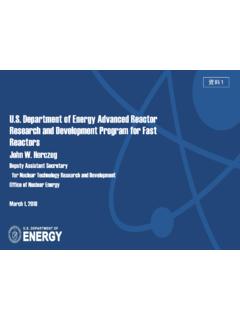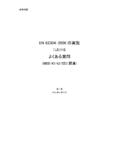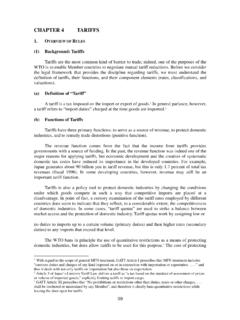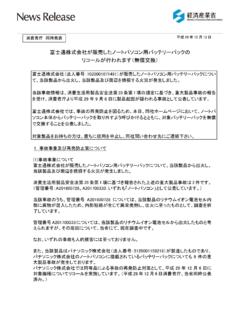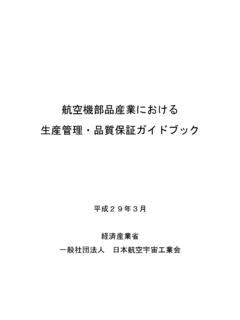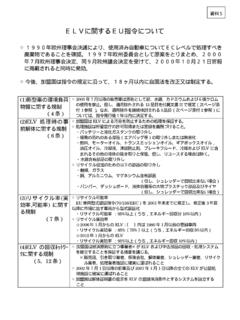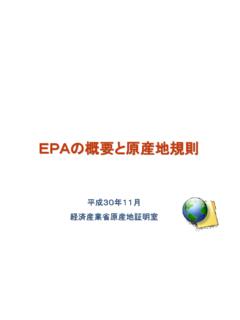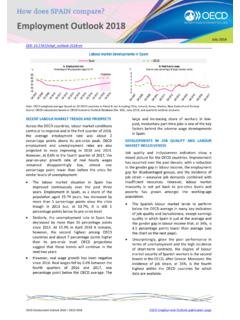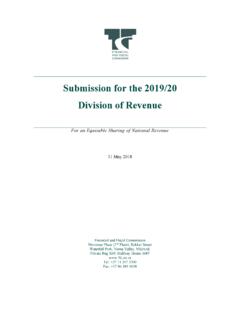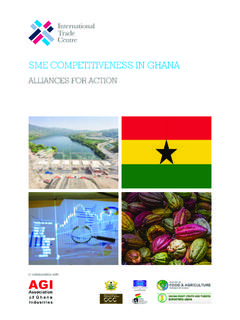Transcription of Long-term Energy Supply and Demand Outlook
1 Provisional Translation Long-term Energy Supply and Demand Outlook July, 2015 . Ministry of Economy, Trade and Industry (Introduction). Following the Strategic Energy Plan, which the Cabinet approved in April 2014, the Ministry of Economy, Trade and Industry (METI). established the Long-term Energy Supply and Demand Subcommittee under the Strategic Policy Committee of the Advisory Committee for Natural Resources and Energy , and after the consideration in the subcommittee, the Long-term Energy Supply and Demand Outlook has been decided. Upon promoting the Energy policy, the Government of Japan (GOJ). and business operators must deeply reflect upon that after the Great East Japan Earthquake and the accident at Tokyo Electric Power Company (TEPCO)'s Fukushima Daiichi Nuclear Power Plants (hereinafter referred to as the TEPCO's Fukushima nuclear accident ), the confidence has been significantly reduced. Approximately 110,000 people are still being forced to live as evacuees at this moment.
2 Efforts toward recovery and reconstruction of Fukushima should be placed at the starting point in order to re-establish the Energy policy. As its top priority, the Government of Japan (GOJ) must do its utmost to achieve the restoration and reconstruction of Fukushima through implementing the measures for decommissioning and contaminated water, compensation for the nuclear accident damage, decontamination, constructing an interim storage facility and control of damage caused by groundless rumors about the accident, and also do its utmost to recover the confidential relationship. The Strategic Energy Plan notes that interest in Energy issues has surged in Japan compared with before the accident, and various people have expressed various opinions, such as 1) that use of nuclear power should be stopped immediately, 2) that nuclear power generation should be abandoned someday if possible, that 3) large-scale, concentrated power sources like nuclear power plants are unnecessary for Japan, 4) that even if nuclear power generation continues, its scale should be kept at a minimum, and that 5) there will be continued need for nuclear power generation, and discussions are ongoing.
3 GOJ must take these various discussions seriously and squarely. Therefore, the subcommittee was held open to the public, and the consideration by the subcommittee referred to various opinions including opinions received through the opinion box regarding Energy mix . which were reported to the subcommittee each time, and finally, after conducting calls for public comment, the Long-term Energy Supply and Demand Outlook has been drawn as below. 1. 1. Position of Long-term Energy Supply and Demand Outlook The point of the Energy policy is to first and foremost ensure stable Supply ( Energy Security ), and realize low-cost Energy Supply by enhancing its efficiency ( Economic Efficiency ) on the premise of Safety. It is also important to make maximum efforts to pursue environment suitability ( Environment ). This has been clarified in the Strategic Energy Plan1 as the basic perspectives for the Energy policy. The Long-term Energy Supply and Demand Outlook is a forecast and also a vision of a desired future Energy Supply - Demand structure to be realized, in light of the Strategic Energy Plan, by executing the policies based on the basic direction of the Energy policy, and assuming the policy goals to be achieved regarding safety, Energy security, economic efficiency and environment which are the basic perspectives for the Energy policy.
4 Accordingly, this Outlook shall be based on the Demand projection in light of the macroeconomic indicators and industrial trends, and shall be a practicable Outlook based on the accumulation of countermeasures and technologies. The Long-term Energy Supply and Demand Outlook draws up the Outlook of the Energy Supply - Demand structure in FY2030 from a mid- to Long-term viewpoint in light of the Strategic Energy Plan. 2. Basic Principle for Drawing the Long-term Energy Supply and Demand Outlook In drawing the Long-term Energy Supply and Demand Outlook , the specific policy goals to be achieved regarding safety, Energy security, economic efficiency and environment which are the basic perspectives mentioned in the Strategic Energy Plan are shown as below. (1) Safety Confidence in nuclear power has been reducing due to TEPCO's Fukushima nuclear accident. In addition, the public are more concerned with resistance of other fuel Supply facilities such as oil and gas, and wind power generation facilities to natural disasters, etc.
5 Therefore, in addition to the world's highest level of the new regulatory requirements, 1. The Strategic Energy Plan is drafted by the Minister of Economy, Trade and Industry and decided by the Cabinet. To draft the plan, the Minister listens to the opinions of the heads of related administrative agencies and the Advisory Committee for Natural Resources and Energy as to the policies, etc. to be comprehensively executed on Energy Supply - Demand based on the Basic Act on Energy Policy (promulgated and enforced in 2002). 2. efforts will be made to voluntarily improve safety, and maintain and develop technologies and human resources necessary for safety securement. Safety improvement will be addressed for oil, gas, and other facilities as well. (2) Energy security It is a significant challenge to realize a multilayer diversified Supply - Demand structure capable of ensuring Energy security not only in normal times, but also in times of crisis. Improvement of Energy self-sufficiency rate has been a major goal of our Energy policy over the years.
6 On the other hand, our Energy self-sufficiency rate has dropped to a mere 6% due to the shutdown of the nuclear power plants, which is the second lowest figure among 34. OECD countries and an extremely low level compared to non-resource-producing countries such as Spain ( ), Italy ( ). and South Korea ( )2. Therefore, the goal is to diversify Energy -supplying countries and develop domestic resources, reduce procurement risks, and improve self-sufficiency rate to the level higher than before the Great East Japan Earthquake (approx. 25%). (3) Economic efficiency Since the Great East Japan Earthquake, the electricity prices have rose greatly for both household and industrial uses, causing an outcry from the industrial sector including small and medium-size enterprises and small-scale business operators in various regions. Therefore, it is an urgent issue to control the electricity prices in order to maintain employment and people's living, and the electricity prices should be controlled stably in the mid-long term as well.
7 Under the circumstances where a positive economic cycle is starting to move in a steady manner, it is important to secure industrial competitiveness and place the Japanese economy on a full-fledged growth track, and is necessary to build an Energy Supply - Demand structure to support economic growth. The government has already been addressing to minimize Energy prices and promote the Energy system reform. On the other hand, dependence on the nuclear power plants will be reduced compared with the level prior to the Great East Japan Earthquake, and use of renewable Energy will be increased, which are large factors pushing up electric 2. The Energy self-sufficiency rates are actual values of 2012 according to IEA Energy Balances 2014. 3. power costs. Therefore, the goal is to lower electric power costs than at present. (4) Environment Since the Great East Japan Earthquake, greenhouse gas (GHG). emissions have been continuously increasing due to the additional thermal power generation caused by the shutdown of the nuclear power plants, etc.
8 , increasing the necessity to address global warming control measures proactively. Under such circumstances, in preparation for the 21st session of the Conferences of Parties (COP21) in December this year, Japan is expected to present an ambitious reduction target and lead the world in tackling global warming as an advanced country. Therefore, the goal is to set the Long-term Energy Supply and Demand Outlook which contributes to a reduction target comparable to EU and the , and lead the world. The Strategic Energy Plan provides the basic direction of the Energy policies such as lowering dependency on nuclear power generation to the extent possible through Energy efficiency and conservation and introducing renewable Energy as well as improving the efficiency of thermal power generation, etc. The basic principle is to draw a future Energy Supply - Demand structural Outlook which achieves the policy goals related to safety, Energy security, economic efficiency and environment suitability assumed above.
9 3. Structural Outlook of Energy Supply and Demand in FY2030. The following describes the Energy Supply - Demand structural Outlook in FY2030 in light of the basic principle mentioned above. (1) Energy Demand and primary Energy Supply structure While expecting an increase in Energy Demand due to economic growth, etc., significant improvement of Energy efficiency, comparable to after the oil shock, is expected by promoting thorough Energy efficiency and conservation. Specifically, based on the economic growth rate estimated referring to the Economic Revitalization Case in Economic and Fiscal Projections 4. for Medium to Long Term Analysis 3 published by the Cabinet Office (Feb. 2015 ), latest population projection by the National Institute of Population and Social Security Research (Medium-Mortality Assumption), activity levels of steel industries, etc., Energy Demand without Energy efficiency and conservation is estimated, and technologically feasible and realistic Energy efficiency and conservation measures in the industrial sector, commercial sector, residential sector and transportation sector are accumulated to achieve approx.
10 Billion liters (crude oil equivalent) in terms of final Energy consumption, resulting in the final Energy consumption of 326 billion liters in FY20304. As a result, the primary Energy Supply structure in FY2030 will be as follows. This will improve our Energy self-sufficiency rate to approx. , which has dropped greatly since the Great East Japan Earthquake5. Also, CO2 emissions from Energy sources will be lower6 than the total GHG emissions in 3. The Economic Revitalization Case assumes the average annual economic growth rate between FY2013 and FY2022 to be in real terms. This is applied to FY2024 onward. 4. Energy efficiency will be improved by 35% by FY2030. 5. Renewable Energy and nuclear are included in Energy self-sufficiency rate as domestic and semi-domestic Energy resources. 6. Greenhouse gas emission reductions in Japan totalize the above-mentioned CO2 emission reductions from Energy sources, other greenhouse gas emission reductions, measures for absorption sources, and the like.
